|
GETAC PS535F
GPS, altimeter, e-compass, camera, hi-res display make this fully rugged Windows Mobile PDA perfect for all sorts of GPS, GIS, surveying, and rescue applications
By Conrad H. Blickenstorfer -- (view review as PDF)
In March of 2009, Getac, ever at the forefront of rugged computer design and manufacturing, announced the latest addition to its comprehensive line of rugged mobile computing solutions. The GETAC PS535F handheld computer is the company's next generation, fully rugged GPS-enabled PDA. The PS535F is a significant technology upgrade to their older PS535E model that we had at the RuggedPCReview.com offices for testing for several months. It's an attractive handheld that sports good industrial design as well as excellent ergonomics and adherence to GETAC's corporate design language. You take one look at this machine and know it's a GETAC.
The hardware
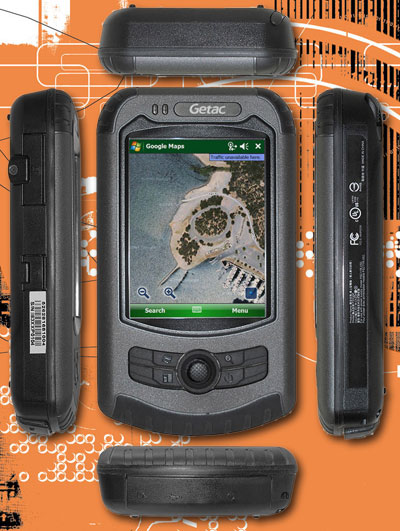 The PS535 platform is a fully rugged PDA based on the Windows Mobile platform. It was conceived to bring general purpose PDA functionality to field-based applications, with special emphasis on GPS/GIS applications. With a footprint of just 3.2 x 5.7 inches and a thickness of just over an inch, the device is small and handy enough to fit into most pockets. Weight is 10.7 ounces including battery. What sets it apart from most rugged Pocket PC-style devices is its integrated high-sensitivity GPS receiver and a full 2GB of NAND Flash. The PS535 platform is a fully rugged PDA based on the Windows Mobile platform. It was conceived to bring general purpose PDA functionality to field-based applications, with special emphasis on GPS/GIS applications. With a footprint of just 3.2 x 5.7 inches and a thickness of just over an inch, the device is small and handy enough to fit into most pockets. Weight is 10.7 ounces including battery. What sets it apart from most rugged Pocket PC-style devices is its integrated high-sensitivity GPS receiver and a full 2GB of NAND Flash.
The new PS535F version adds significant power and functionality. Perhaps most importantly, the 3.5" touchscreen display has been upgraded to full VGA 480 x 640 pixel resolution. That translates into 228dpi (dots per inch), considerably sharper even than the vaunted Apple iPhone's 162dpi. Combined with sunlight-readable display technology, the much higher resolution dramatically enhances the viewing quality of graphic-intensive files and detailed maps, even in bright daylight or snowy conditions.
The new model also includes a built-in 3-megapixel auto-focus camera, an altimeter and an E-compass. These new features are meant to let field-based users capture a much richer, expanded range of field data on-site. Combined with the PS535F's pinpoint DGPS navigation accuracy of three to 10 feet, this rugged GETAC handheld offers plenty of location-based systems functionality, which is critical with applications such as search-and-rescue missions and similar deployments.
The PS535F handheld PDA is also well suited for a variety of GIS surveying applications across different sectors including utilities, oil and gas, forest patrol, and surveying and mapping of geology and mineral resources. The built-in camera enables instant visual data capture on location and its resolution and quality are high enough so that taking a (fragile) camera along is not necessary. A GETAC Bluetooth modem or mobile phone can be used to connect the PS535F to a GIS server and instantly transmit or process data in the field.
The built-in altimeter and E-compass are meant to complement GPS functionality by providing advanced navigation features such as fixed positioning of longitude, latitude and altitude, as well as the ability to provide directional relations between a targeted subject and the user's position. There are a lot of tools built into this unit that, combined with the proper software, make entirely new applications possible, applications that in the past either required multiple devices or simply were not available in the field.
Those interested in technical matters will notice that the GETAC PS535F is powered not by one of the almost ubiquitous Marvell PXA XScale processors, but by the 533MHz version of Samsung's S3C2450 application processor. This is a 32/16-bit 65nm low power RISC microprocessor that was designed for general applications including the GPS/GIS and smartphone markets. Compared to the predecessor S3C2443 chip, the 2450 was upgraded to the ARM926EJ core, has a 2D graphics accelerator, a low power mode, and embedded internal ROM/RAM for secure boot and low power audio decoding. The chip also includes an advanced camera interface, USB 2.0 capability, and SDHC and HS-SPI port support (click here for Samsung S3C2450 processor detail).
Windows Mobile
The GETAC PS535F comes with Windows Mobile 6.1. Compared to earlier versions of Windows Mobile, Windows Mobile 6.1 offers instant messaging-like texting, improved browsing, simpler email and Bluetooth setup, security enhancements, and an improved Home screen interface. Anyone who has ever used a Windows Mobile device will instantly be familiar with the rich functionality and the mobile versions of the major Microsoft Office applications (Word, Excel, Powerpoint, Outlook, Internet Explorer). Operations is via stylus, touch, a five-way navigation stick, and four hardware application buttons.
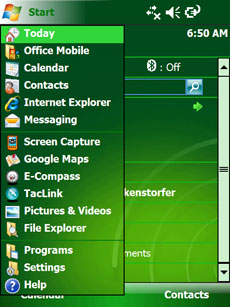 Why did GETAC choose Windows Mobile instead of Windows CE .NET or Windows CE 5.0 or 6.0 with their more industrial look and feel and functionality? These days, Microsoft differentiates between Windows Embedded CE and Windows Mobile. Windows Embedded CE is a scalable 32-bit OS designed for intelligent devices ranging from enterprise tools such as industrial controllers, communications hubs, and point-of-sale terminals to consumer products such as cameras, phones, and home entertainment devices. Why did GETAC choose Windows Mobile instead of Windows CE .NET or Windows CE 5.0 or 6.0 with their more industrial look and feel and functionality? These days, Microsoft differentiates between Windows Embedded CE and Windows Mobile. Windows Embedded CE is a scalable 32-bit OS designed for intelligent devices ranging from enterprise tools such as industrial controllers, communications hubs, and point-of-sale terminals to consumer products such as cameras, phones, and home entertainment devices.
The differentiation can be a bit confusing. Microsoft uses the term "Embedded CE" for both early versions of Windows CE that were used in both consumer and industrial devices (such as Windows CE 2.1 and 3.0) as well as for more recent versions released after industrial handhelds split away from the more consumer/business-oriented Pocket PC and smartphone devices (such as Windows CE .NET and then Windows CE 5.0 and 6.0). While the CE .NET and CE variants can (and often do) include multimedia, PIM applications and communications tools, they don't have the polished Today screen and all the Pocket PC functionality and Pocket versions of popular Windows applications users have become familiar with.
Windows Mobile, on the other hand, is a platform that is also based on Windows Embedded CE, but has the more consumer-oriented look and feel and features required for PDAs and smartphones. For a device like the GETAC 535F, the decision between Windows CE and Windows Mobile was probably a toss-up, with GETAC deciding that the target customers for this device would prefer the friendlier Windows Mobile platform with its wealth of general purpose apps as opposed to the sparser Windows CE platform where customers generally create their own applications.
Connectivity
For onboard connectivity there is a microphone/headphone jack, a mini-B USB port, a power jack, and a SD Card slot that is sealed with a screw-down cover. The mini-B USB port and the power jack are at the bottom of the device, hidden beneath a thick protective rubber plug.
On the wireless side, the PS535F comes with 802.11b/g WiFi and Bluetooth V2.0 with EDR (Enhanced Data Rate). GETAC also offers an optional Bluetooth EDGE WWAN radio modem for high-speed data transfer when away from local wireless networks and hotspots.
Since the PS535F was not designed to be a phone as well, there is no SIM slot.
Integrated 3-megapixel camera
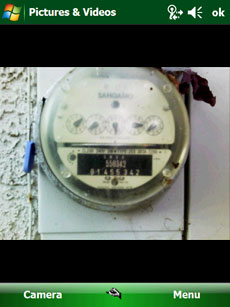 Like almost all cellphones and netbooks, and a increasing number of handheld computers, the GETAC PS535F has an integrated camera. It offers 3-megapixel resolution, which is more than the iPhone and as much as dedicated digital cameras had just a few years ago. You can pick from five white balance settings, do exposure compensation, shoot in burst mode or time delay, and record at six different resolutions ranging from a maximum of 2048 x 1536 pixels all the way down to 160 x 120 pixel. You can then view pictures, directly send them via email, beam them via Bluetooth, or assign them to a contact. The camera also seems to be able to do video. All of this is done via the standard Windows Mobile Pictures & Videos app. Like almost all cellphones and netbooks, and a increasing number of handheld computers, the GETAC PS535F has an integrated camera. It offers 3-megapixel resolution, which is more than the iPhone and as much as dedicated digital cameras had just a few years ago. You can pick from five white balance settings, do exposure compensation, shoot in burst mode or time delay, and record at six different resolutions ranging from a maximum of 2048 x 1536 pixels all the way down to 160 x 120 pixel. You can then view pictures, directly send them via email, beam them via Bluetooth, or assign them to a contact. The camera also seems to be able to do video. All of this is done via the standard Windows Mobile Pictures & Videos app.
Having an integrated camera can come in handy to document projects in various ways. Custom apps can probably access the camera and perhaps do interesting things like geotagging. The camera's 3-megapixel resolution is certainly high enough. Integrated camera modules, however, have a reputation for producing low quality pictures. In order to be truly useful on the job, an integrated camera must be able to capture sharp, detailed images.
The three shots below were taken on a sunny day. They are quite good, but it must be understood that in terms of quality the integrated camera cannot replace a dedicated camera.

Click to see left image — center image — right image full size
Controls and input
 The GETAC PS535F is configured as a traditional Pocket PC/PDA, which means you interact with it via touch screen and not via a keyboard or keypad. Hardware controls are minimal. There is a recessed five-way navigation stick flanked by two push button areas to the left and right of it. On the left are Start Menu and Contacts, on the right Power and GPS applications. The three program buttons are customizable although they carry imprinted labels with their default functions. There are no other hardware controls. The GETAC PS535F is configured as a traditional Pocket PC/PDA, which means you interact with it via touch screen and not via a keyboard or keypad. Hardware controls are minimal. There is a recessed five-way navigation stick flanked by two push button areas to the left and right of it. On the left are Start Menu and Contacts, on the right Power and GPS applications. The three program buttons are customizable although they carry imprinted labels with their default functions. There are no other hardware controls.
Above the display are two indicator lights. The one to the left glows blue when wireless is on. The one to the right is a multifunction light that indicates battery status (green = full, red = low, amber = charging) and notifications (flashing).
For audio, there is a microphone below the navigation stick, a speaker in the back, and a headphone connector on the left.
Operation is generally via stylus, with the supplied collapsible stylus extending to 4-1/2 inches and fitting into a slot on the upper right. Touch works as well, but the interface is cearly designed for a stylus.
For data entry, Windows Mobile offers a wealth of options. There is a nice pop-up keyboard and three are also no fewer than three different ways of recognizing text. They are:
- Block Recognizer, which uses the special Graffiti alphabet Palm invented in the 1990s. The idea here is that almost all letters are "unistrokes," or consisting of a single uniterrupted stroke, which makes them easy to recognize for the computer. The slightly abstracted alphabet is quite easy to learn. Millions used it on Palm Pilots.
- Letter Recognizer, which also recognizes individual letters instead of whole words, but uses the standard alphabet instead of the slightly modified one of the Block Recognizer. And whereas the Block Recognizer lets you shift case, the Letter Recognizer, which goes back to a product called "Jot" by (CIC) Communiation Intelligence Corporation, has different data entry boxes for upper case, lower case and numerals.
- Transcriber, which is a full-function handwriting recognition system that also goes way back almost to the beginning of PDAs more than 15 years ago. Microsoft bought the rights to it a number of years ago and it's been part of Windows Mobile ever since.
Any of those input methods, once mastered, work very well. Below you can see screenshots of the onscreen keyboard, the Block Recognizer, and Transcriber.

If required, GETAC also offers an optional cordless 1D barcode reader and a cordless RFID reader for additional data capture capabilities.
GPS and mapping
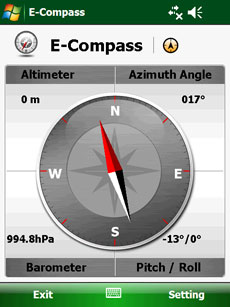 The GETAC PS535F has a 20-channel L1 C/A-code GPS receiver based on the integrated SiRFstarIII GPS microcontroller chipset. L1 means it's using the 1575.42 MHz satellite frequency in coarse-acquisition mode. Using differential GPS technology (DGPS) to correct for naturally occuring GPS errors, the GETAC can get horizontal accuracy of three to ten feet. That is very accurate and enough for most mapping and GPS applications. The GETAC PS535F has a 20-channel L1 C/A-code GPS receiver based on the integrated SiRFstarIII GPS microcontroller chipset. L1 means it's using the 1575.42 MHz satellite frequency in coarse-acquisition mode. Using differential GPS technology (DGPS) to correct for naturally occuring GPS errors, the GETAC can get horizontal accuracy of three to ten feet. That is very accurate and enough for most mapping and GPS applications.
The device includes a separate altimeter, is able to determine pitch and roll, probably via an accelerometer, and can also detect barometric pressure. There is an e-Compass (see screen capture on the right) that displays direction as well as altitude, barometer reading, pitch/roll in degrees, and Azimuth Angle. The e-Compass can be set so that either the needle or the wheel rotates, and altitude can be set to GPS or the built-in altimeter. Altitude, for now, is only shown in meters, so those used to the imperial system need to do mental conversions.
The pictures below show the supplied TacLink utility that displays pertinent satellite data on the left, and two screens from Google Maps, a freebie download directly from the web to the PS535F device. Google Maps uses the integrated GPS and can show both maps and satellite images. You can locate yourself on the map, and -- not surprisingly -- the accuracy is stunning. As I walked around a building, the GETAC handheld showed me exactly where I was (and by exactly I mean just that; not in the general vicinity).
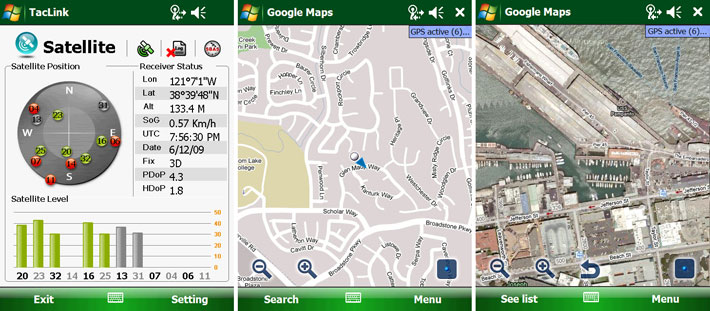
Power
Battery life is always an issue when you're in the field and the next charger is miles away. GETAC rates the PS535F's 3.7 Volt/2,400mAH Li-Ion powerpack as good for operating the device at full capacity for up to eight hours--a full shift--on a fully-charged battery. The long battery life is good as you can't simply pop a spare into the unit; the battery sits under a cover that is tightly held in place by four small Philips screws. The battery itself is a proprietary unit with a thin wire cable and a little plug as opposed to the surface contacts of most batteries.
Backlight intensity, backlight shut-off and device shutoff can all be used to optimize battery life. Since Windows Mobile devices are instant-on, it's generally good practice to have the device quickly go to sleep when it is not used. This can greatly extend battery life, though it can also be annoying to have to wake it up all the time.
Ruggedness
The GETAC PS535F is a rugged device and has been tested according to MIL-STD 810F procedures in all relevant areas. It also carries an IP54 ingress protection rating and was generally designed to operate without failure under the most extreme weather conditions, environments and everyday abuse associated with its user base. Specifically, the device is fully dust-proof and is protected from water spray from all directions. It can survive 5-foot drops onto all faces and corners onto steel, has a very wide operating temperature range of -4 to 140 degrees Fahrenheit, and also passes the "tumble test" that calls for 1,000 1.6 foot tumble cycles.
In May of 2010, Getac announced that the PS535's ingress protection rating had been boosted to IP65. That means the device is now totally protected against dust, and can handle low pressure water jets (as opposed to just spray) from all directions.
Summary
The GETAC PS535F is a rugged handheld computer that offers a well-balanced combination of Pocket PC convenience and targeted professional features. 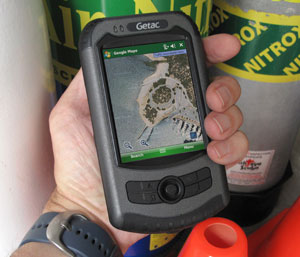 It is running the Windows Mobile 6.1 operating environment, which means it comes with Office Mobile (Word, Excel, PowerPoint), Internet Explorer, email, messaging, calendar, tasks, contacts and all the other goodies most of us have come to rely on. It also has Windows Live, the Windows Media player and a good complement of utilities and security features. It is running the Windows Mobile 6.1 operating environment, which means it comes with Office Mobile (Word, Excel, PowerPoint), Internet Explorer, email, messaging, calendar, tasks, contacts and all the other goodies most of us have come to rely on. It also has Windows Live, the Windows Media player and a good complement of utilities and security features.
However, this handheld offers far more than just standard PDA functionality. For one thing, it's rugged enough to survive rain, dust, drops and all sorts of abuse. It also has a 3-megapixel camera, a very accurate GPS receiver, an electronic compass, and an altimeter. Add to that a super-sharp 3.5-inch touch display with full 480 x 640 pixel resolution, and you have a device that is ideal for all sorts of GPS, GIS and mapping applications.
As for its intended use and application, GETAC president Jim Rimay said, "Our customers typically work in high-intensity environments and situations, which demand seamless and accurate information exchange between the main office and field workers. The PS535F is the ideal solution for any field application that requires immediate response and action such as fire and rescue teams, utilities technicians, and Park Rangers. A great example is forest patrols reporting the location and fire hazard conditions to a fire center to assist fire rescue planning. Ultimately, GETAC's PS535F handheld device improves overall operational efficiencies and productivity, which for firefighters can be a lifesaving feature."
– Conrad H. Blickenstorfer, March and June 2009
|
GETAC PS535F Specifications
|
| Added/changed |
Added 3/2009; updated with full review 6/2009; updated 5/2010 (IP65)
|
| Type |
Rugged handheld terminal
|
| Processor |
533MHz Samsung S3C2450 |
| OS |
Windows Mobile 6.1 |
| GPS |
SiRFstarIII L1(C/A) 20 channel with horizontal DGPS accuracy of 1-3 meters |
| RAM/ROM |
128MB/2GB NAND FLASH |
| Display |
3.5" transflective TFT with VGA (480 x 640 pixel) resolution and LED backlight |
| Digitizer/Pens |
Touchscreen/1 telescopic stylus |
| Keyboard/keys |
Onscreen |
| Navigation |
4-way directional control and stylus/touch |
| Expansion slots |
1 SD/SDHC Card slot, sealed but externally accessible |
| Housing |
ABS plastic with rubberized bumper areas |
| Size |
3.2 x 5.7 x 1.2 inches |
| Weight |
10.7 oz. as tested |
| Temperature |
-4 to 140 degrees Fahrenheit |
| Ingress Protection |
IP54; IP65 as of May 2010 |
| Drop |
MIL-STD-810F, Method 516.5, Procedure IV (5-foot) |
| Vibration |
MIL-STD-810F, Method 514.5, Procedure I |
| Humidity |
MIL-STD 810F Method 507.4 |
| Tumble |
1,000 1.6 ft./.5 m tumbles (2,000 drops) |
| ESD |
IEC61000-4-2 / EN55024 |
| Regulatory |
CE, FCC, UL, BSMI, NCC, CCC, SRRC |
| Power |
3.7 V/2,400mAH Li-Ion "8-hour battery life" |
| Communication |
SiRF Star III, 802.11b/g WiFi, Bluetooth V2.0 + EDR, 3.0-megapixel camera, altimeter, compass; optional cordless 1D Bardcode Reader, cordless RFID reader, BT EDGE WWAN modem |
| Interface |
USB 1.1, microphone, line-out, MMCX GPS antenna connector, power |
Price |
Starting at US$1,099 |
| Contact |
GETAC us.getac.com -- 1-866-464-3822 |
|
|








